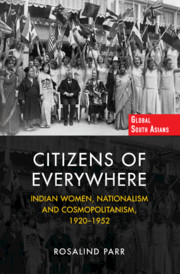Book contents
- Frontmatter
- Dedication
- Contents
- List of Figures
- Acknowledgements
- Note on Spelling
- List of Abbreviations
- Introduction: Cosmopolitanism, Nationalism and the Global Public Sphere
- 1 The Cosmopolitan-Nationalism of Sarojini Naidu
- 2 Suffrage; Solidarity
- 3 Becoming Global Citizens
- 4 Breaking America
- 5 A Changing World Order?
- 6 Defining Human Rights
- Conclusion
- Appendix 1 Dramatis Personae
- Appendix 2 The Universal Declaration of Human Rights
- Bibliography
- Index
Introduction: Cosmopolitanism, Nationalism and the Global Public Sphere
Published online by Cambridge University Press: 06 August 2021
- Frontmatter
- Dedication
- Contents
- List of Figures
- Acknowledgements
- Note on Spelling
- List of Abbreviations
- Introduction: Cosmopolitanism, Nationalism and the Global Public Sphere
- 1 The Cosmopolitan-Nationalism of Sarojini Naidu
- 2 Suffrage; Solidarity
- 3 Becoming Global Citizens
- 4 Breaking America
- 5 A Changing World Order?
- 6 Defining Human Rights
- Conclusion
- Appendix 1 Dramatis Personae
- Appendix 2 The Universal Declaration of Human Rights
- Bibliography
- Index
Summary
‘Indian women are taking a lead in the councils of the world,’ announced the British feminist Grace Lankester in a report on the 1946 meeting of the All-India Women's Conference (AIWC). Indeed, although India was not yet independent, a small number of Indian women created a notable presence on the world stage. Amongst them, Amrit Kaur had led India's delegation to the United Nations Economic and Social Conference (UNESCO) in 1945 and 1946 and would later be elected President of the World Health Organisation (WHO). Kaur's colleague Hansa Mehta was one of seven women on the United Nations (UN) Sub-Commission on the Status of Women in early 1946 and would represent India on the Commission on Human Rights between 1947 and 1952. The Indian woman with the highest international profile at this point was Vijaya Lakshmi Pandit, the only woman to lead a national delegation at the First Session of the UN General Assembly. It was Pandit's campaign against the Union of South Africa's race policy at the UN in late 1946 that announced soon-to-be-independent India's aspiring leadership on the international stage. As Lankester observed, these women's achievements marked India out: ‘Compare this record with British women's representation on International bodies,’ she remarked.
The prominence of Indian women on the international stage in 1946 reflects a historical process that has largely gone unnoticed. For over two decades, women associated with the anti-colonial movement had been internationally active in global civil society. They had forged supportive transnational networks, engaged with public opinion and established connections to international institutions. Through these activities, they gained widespread recognition in ways that legitimised the Indian nationalist cause and bolstered the credibility of the emerging postcolonial state. Beyond this set of nationalist achievements, women's international activism had global significance. By contributing to wide-ranging debates about the future of the world, they shaped the language and practice of liberal internationalism, including the discourse of women's rights. AIWC leaders were at the forefront of these efforts. Having secured allies in the international women's movement, in 1937, the organisation circumvented imperial influence to become a ‘correspondent member’ at the League of Nations. Meanwhile, they sought solidarity and influence elsewhere. Attempts were made to establish a new pan-Asian framework for women's activism. At the same time, activists set their sights on the United States of America.
- Type
- Chapter
- Information
- Citizens of EverywhereIndian Women, Nationalism and Cosmopolitanism, 1920–1952, pp. 1 - 16Publisher: Cambridge University PressPrint publication year: 2021

